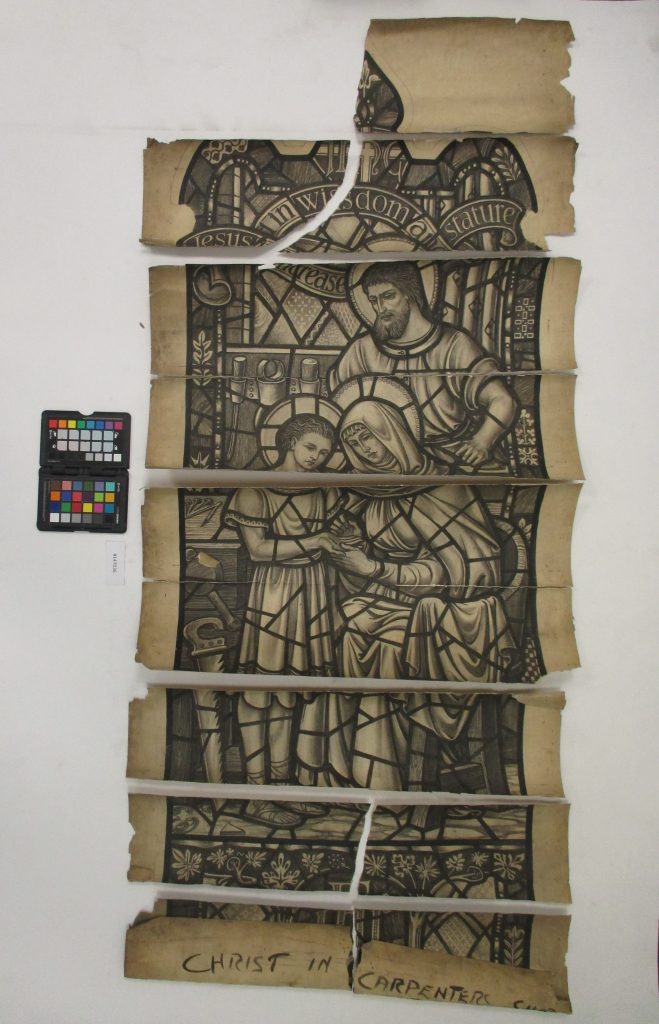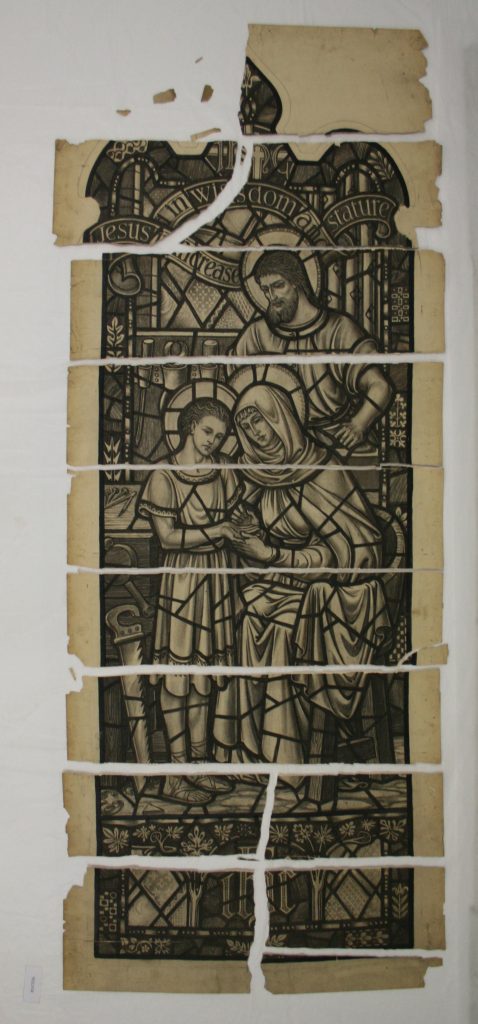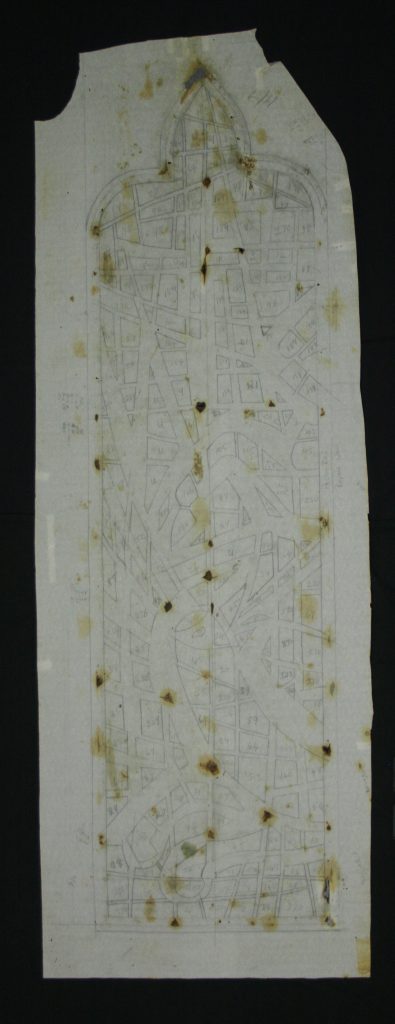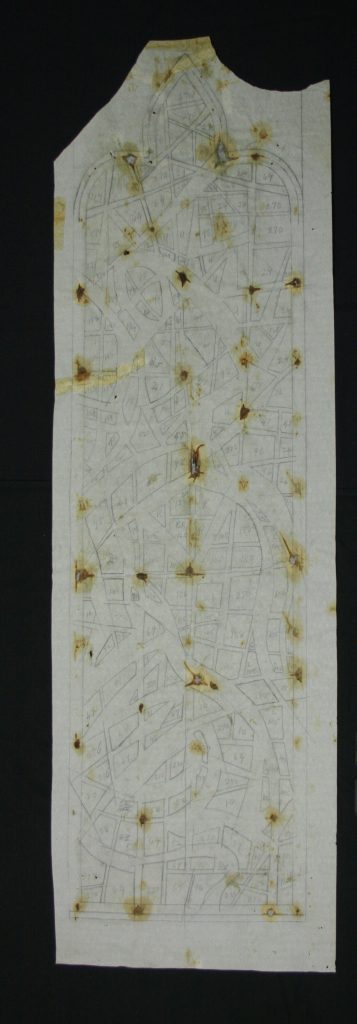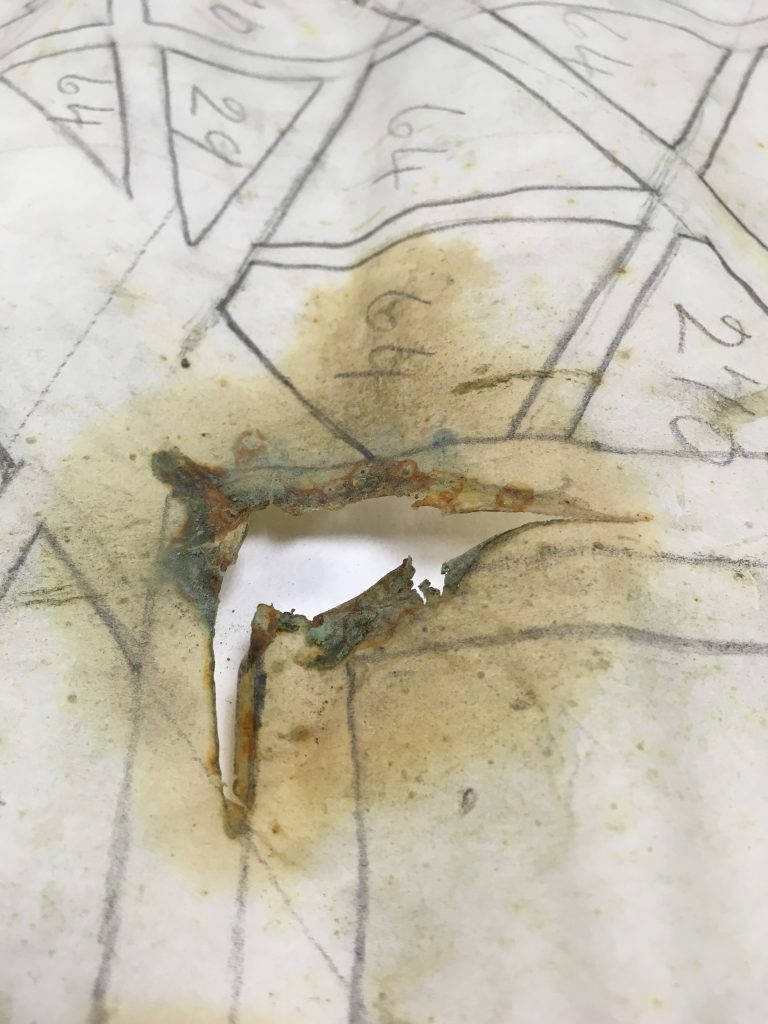This post comes from Colette Peavy and Pascual Ruiz Segura, Rakow Research Library interns working on the conservation of the Whitefriars stained glass cartoon collection over the summer of 2017, in conjunction with West Lake Conservators. Read more about this project and the collection in previous posts.
 Over the past 13 weeks, we treated a total of 10 Whitefriars rolls containing 136 objects on a wide variety of materials, including cartoons, silver-gelatin photographs, wax canvases, and tracing papers. The majority of the rolls we treated were from the Eastern half of the United States, with a few from England and New Mexico. Although this is just a small part of the total Whitefriars collection, our contribution has expanded the number of conserved materials that will be digitized for use by a worldwide audience.
Over the past 13 weeks, we treated a total of 10 Whitefriars rolls containing 136 objects on a wide variety of materials, including cartoons, silver-gelatin photographs, wax canvases, and tracing papers. The majority of the rolls we treated were from the Eastern half of the United States, with a few from England and New Mexico. Although this is just a small part of the total Whitefriars collection, our contribution has expanded the number of conserved materials that will be digitized for use by a worldwide audience.
We ended our summer in the conservation lab with an object from an unknown roll. This is the first time in the course of the Whitefriars project that an unknown roll has been treated. We had hoped to find some clues about where this design was from, but alas, we had no such luck. (If you recognize it, let us know!) The words “Christ in Carpenter’s Shop” are written on the back of the cartoon. The cartoon was brittle and had split into many pieces. We cleaned and humidified the cartoon, and it’s now drying safely in between sheets of blotter paper.
- The object from the unknown roll before flattening. CMGL 147036.
- The object after flattening. CMGL 147036.
Because this is our final post, we’d each like to share some thoughts about our internship and working with the Whitefriars collection.
Colette
This summer has been a great experience for me. It was exciting to be part of an ongoing project and contribute new information to the Whitefriars collection here at the Rakow Library. Each summer, more pieces of the puzzle are discovered, and we are slowly putting together the various working processes of the stained glass artists and designers at Whitefriars. The opportunity to work on a portion of this collection has taught me more about stained glass than I thought I’d ever know.
Information gathered by previous interns concerning the dalle de verre technique proved useful when we treated designs done on tracing paper. The burns and corrosion product we found on these objects were similar to objects they had treated. The design of the cartoon as well as these burns indicate that these tracings were used in windows created using this technique.
- A tracing we treated from a roll labelled “Wealdstone.”
- A tracing we treated from a roll labelled “Wealdstone.”
- Corrosion product around a burn on the tracing paper.
The materials used in the design process were more varied that I had originally expected, making opening each new roll an exciting experience. The items we treated from Liverpool Cathedral illustrated the diversity of materials used in the design process. The reconstruction of the windows that were destroyed in the Lady Chapel was done using photographs of the original cartoons, photographs of prints, and a portrait. The women in these photos were then traced from the photographs, as were some of the decorative elements.
The opportunity to work on a Whitefriars cartoon from my hometown made the project more important to me, and really highlighted that Whitefriars windows can be found across the globe. I will be on the lookout for little white friars in the bottoms of stained glass windows from now on!
Pascual
A few months ago, I wouldn’t have expected to feel so enthusiastic about stained glass. In fact, I knew little about Corning or the Rakow Library. Nowadays, I still don’t know much about the wide field of stained glass production and its techniques. I do know a little bit more about the magnificent collection of stained glass designs at the Rakow Library. These 13 weeks I learned about and enjoyed working on the conservation of this invaluable collection of cartoons, wax canvases, tracing papers, and silver-gelatin photographs. These are the kind of works we found this year, but who knows what else is waiting inside all the unopened rolls that sleep on the shelves of the archive.
For me, a paper conservator, the Whitefriars collection offered the opportunity to work on oversized objects, and all the challenges that this entails. How to hold the works, how much space is required to do the treatments, and how to store them once they are finished becomes a jigsaw puzzle. As we mentioned in our first post this year, these are some of the hardest challenges that the collection offers to a paper conservator.
Now, our time working on the Whitefriars conservation project, this year, is over. Actually, this post is published several weeks after we left the conservation lab from the Rakow Library. But don’t be sad! Not only did we leave this post and others, we also left a great number of Whitefriars works newly-conserved and ready for digitization. Best of all, in the coming weeks, a team who specializes in digitization will help make all these works available for users around the world. Soon everybody will be able to dive into the Whitefriars collection and delight in the colors and fine strokes used on the cartoons.
We hope that people will continue to be interested in conservation of paper-based collections, and of the Whitefriars collection in particular, as this year proved to us. Because next year new stories will come from new interns, the Rakow Library, and — of course! — the Whitefriars collection.
Follow the progress of the 2017 project.
The Rakow Research Library is open to the public 9 am to 5 pm every day. We encourage everyone to explore our collections in person or online. If you have questions or need help with your research, please use our Ask a Glass Question service.

